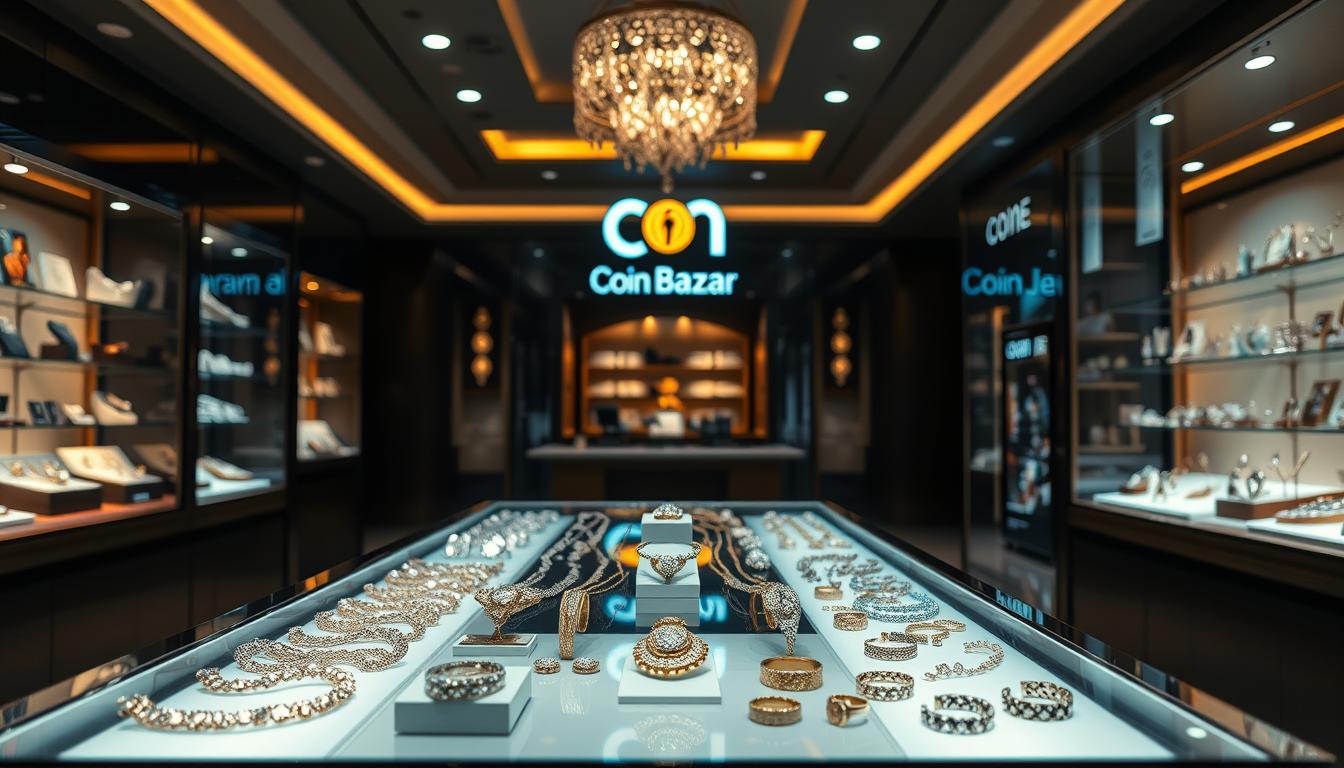Thinking about starting in duty-free jewelry exports? You’re on your way to a promising international market. The Niryat Bandhu scheme by the Office of the Joint Director General of Foreign Trade is here to help. It’s a detailed guide for newcomers, covering the basics of international jewelry duty-free exports.
This guide will help you understand the industry’s ups and downs. It’s packed with tips and advice to help you succeed in duty-free exports.
Key Takeaways
- Understanding the Niryat Bandhu scheme and its benefits for exporters
- Navigating the process of duty-free jewelry exports
- Identifying opportunities and challenges in the international jewelry market
- Strategies for new entrants to succeed in duty-free jewelry exports
- Compliance and regulatory considerations for exporters
The World of Duty Free Jewelry: Opportunities for New Exporters
Duty-free jewelry exports are a great chance for new businesses to grow globally. Exporting is key to economic growth. So, entering the duty-free jewelry market can help businesses expand worldwide.


What Constitutes Duty-Free Jewelry Products
Duty-free jewelry doesn’t have to pay some taxes and duties when shipped out. This includes everything from luxury jewelry to affordable fine jewelry. Knowing what’s duty-free is important for exporters to use these breaks.
Economic Advantages of Duty-Free Export Markets
Exporting duty-free jewelry can really increase a company’s earnings. By skipping some taxes and duties, businesses can sell their items cheaper abroad. This makes their products more appealing to buyers.
Why India is Positioned for Success in This Sector
India is famous for its jewelry making and is ready to take advantage of the duty-free jewelry trend. With smart strategies and knowledge of the global market, Indian exporters can make a big impact in the duty-free shopping world.
Global Landscape of Duty-Free Jewelry Trade
The global duty-free jewelry trade is growing fast, opening up new chances for exporters. It’s key for businesses to know the current market well if they want to grow globally.
Current Market Size and Growth Projections
The duty-free jewelry market has grown a lot in the last few years. This growth is thanks to more people wanting luxury items like duty-free diamond rings. Experts think this trend will keep going, with new markets playing a big part.


Major Destination Markets for Indian Jewelry
Indian jewelry exporters have several important markets to focus on. The United States, the Middle East, and Europe are big ones. These places are where people are looking for duty-free jewelry deals. Knowing what these markets like is crucial for success.
Consumer Preferences in International Markets
What people like varies a lot around the world. Some areas like traditional designs, while others prefer modern, simple styles. Exporters need to know these differences to make products that appeal to more people and meet the growing demand for duty-free jewelry.
Legal Framework for Jewelry Exports from India
To export jewelry from India, knowing the legal rules is key. The Foreign Trade (Development & Regulation) Act, 1992, and its rules are at the heart of India’s trade laws.
Indian Export Regulations and Policies
India’s export rules help trade flow smoothly and meet global standards. The Gem and Jewelry Export Promotion Council (GJEPC) is vital in boosting Indian jewelry sales worldwide.
Gem and Jewelry Export Promotion Council (GJEPC) Guidelines
The GJEPC sets rules for exporters. These cover quality, packaging, and export papers. Following these rules is vital for India’s good name in jewelry trade.
Foreign Trade Policy Provisions
The Foreign Trade Policy sets out how to export goods from India. It offers benefits like duty breaks and schemes to help exports grow.
International Trade Agreements Benefiting Indian Exporters
India’s part in global trade deals, like free trade agreements (FTAs) and preferential trade agreements (PTAs), helps jewelry sellers. These deals cut or remove tariffs, making Indian jewelry more appealing abroad.
By grasping and using these laws and deals, Indian jewelry makers can better face global trade. This boosts their chances in the world market.
Setting Up Your Jewelry Export Business in India
Starting your jewelry export business in India is exciting. First, you must set up a business and get an Importer-Exporter Code number.
Business Structure Options for Exporters
You can pick from several business types. These include sole proprietorship, partnership, or private limited company. Each has its own benefits and rules to follow.
Required Licenses and Registrations
You’ll need to get the right licenses and registrations to run your business legally. Import-Export Code (IEC) Acquisition is a key step.
Import-Export Code (IEC) Acquisition
Getting an IEC is essential for exporting jewelry. It’s a 10-digit code from the Directorate General of Foreign Trade.
GJEPC Membership Process
Joining the Gem & Jewelry Export Promotion Council (GJEPC) offers great benefits. You’ll get access to markets and insights into the industry.
Tax Registrations and Compliance Requirements
You must follow tax rules, including GST registrations. Staying tax compliant is crucial for your business’s success.
“The key to successful exporting lies in understanding and complying with the regulatory framework,” experts say. Having the right licenses and registrations helps you deal with the jewelry export market’s challenges.
Understanding Duty-Free Zones and Operations
To grow your jewelry export business, knowing how duty-free zones work is key. These zones, like Special Economic Zones (SEZs) and Free Trade Warehousing Zones (FTWZs), offer big benefits. They exempt you from some duties and taxes.
Special Economic Zones (SEZs) in India for Jewelry
SEZs are special areas in India with their own rules. They give perks like duty-free imports and tax breaks. For jewelry makers, SEZs are a great place to start or grow your business.
Free Trade Warehousing Zones (FTWZs)
FTWZs let you store goods without paying customs duties. They’re great for jewelry exporters who need to keep their products before shipping them abroad.
Operating Procedures in Duty-Free Environments
Working in duty-free zones means following certain rules. You must stick to customs laws, keep good records, and follow the right steps for moving goods in and out.
| Zone Type | Key Benefits | Regulatory Compliance |
|---|---|---|
| SEZs | Duty-free imports, tax exemptions | Streamlined regulatory compliance |
| FTWZs | Duty-free storage, simplified customs | Accurate record-keeping, customs compliance |
By using duty-free zones wisely, you can make your jewelry export business more efficient and profitable.
Harmonized System (HS) Codes and Tariff Classifications
When you look into the global market for duty-free jewelry, knowing about HS code classification is key. The Harmonized System (HS) is a global standard for naming and numbering traded products. For those who export jewelry, understanding HS codes is essential to know if your products are duty-free.
Essential HS Codes for Jewelry Categories
Jewelry falls under different HS codes based on its material and type. For example, duty-free diamond rings have their own code, unlike silver or gold jewelry. Knowing these codes is the first step to successfully exporting international jewelry duty-free.
| Jewelry Category | HS Code | Description |
|---|---|---|
| Diamond Rings | 7102.39.00 | Diamond jewelry, not elsewhere specified |
| Gold Jewelry | 7113.19.00 | Gold jewelry, not elsewhere specified |
| Silver Jewelry | 7113.11.00 | Silver jewelry, not elsewhere specified |
How Classification Affects Duty-Free Status
The right HS code for your jewelry is crucial for its duty-free status. The wrong code can cause delays or penalties.
Common Classification Mistakes to Avoid
One big mistake is misclassifying jewelry pieces or not keeping up with code changes. Staying informed and getting advice from trade experts can help you avoid these errors.
Sourcing Materials for Export-Quality Jewelry
To make export-quality jewelry, you must find the best raw materials. It’s key to get materials that meet international standards. This way, you can offer affordable fine jewelry and duty-free jewelry deals to global buyers.
Domestic Sourcing Options in India
India has many options for jewelry makers. It’s famous for skilled workers and lots of precious metals and stones.
Diamond Markets: Surat and Mumbai
Surat and Mumbai are big for diamond work. Surat is especially known for handling a lot of diamonds. Surat’s diamond work shows India’s skill in diamond processing.
Gold and Silver Sourcing
Gold and silver are key for jewelry. India has a strong market for these metals, with many suppliers and refineries.
“India’s gold and silver market is strong, meeting the needs of jewelry makers.”
Import Considerations for Raw Materials
Importing materials is also common. Exporters need to know about import rules and tariffs for stones and metals.
Ethical Sourcing and Compliance
Ethical sourcing is now crucial in jewelry. Exporters must follow global rules and ethics. This means getting conflict-free diamonds and materials responsibly.
By using both local and international sources, and following ethics, jewelry makers can keep quality high. They can also meet the growing need for duty-free jewelry deals.
Quality Standards and Certification for International Markets
When you start exporting duty-free jewelry, knowing about quality standards and certifications is key. Following international quality standards helps you enter global markets. It also lets you enjoy the luxury jewelry tax exemption benefits.
Quality standards and certifications show your jewelry’s excellence. In India, the Bureau of Indian Standards (BIS) hallmarking is vital. It confirms the purity of precious metals in your jewelry.
Indian Standards: BIS Hallmarking and Quality Control
The BIS hallmarking scheme ensures the quality and purity of gold and silver jewelry. It checks the purity of precious metals and marks jewelry with a hallmark. This hallmark is recognized worldwide. To enjoy duty-free shopping perks, your jewelry must meet these standards.
International Certification Requirements
For international markets, you need various certifications to follow global quality standards. Two important ones are the Kimberley Process for diamonds and precious metal purity standards.
Kimberley Process for Diamonds
The Kimberley Process is a global certification that confirms diamonds are conflict-free. As a jewelry exporter, getting this certification is crucial for selling diamonds worldwide.
Precious Metal Purity Standards
Precious metal purity standards differ by country but aim for the same goal: ensuring jewelry meets purity criteria. For example, gold jewelry is often expected to be at least 14K or 18K. Knowing these standards is essential for getting luxury jewelry tax exemption benefits in various markets.
Laboratory Testing and Quality Assurance Processes
Laboratory testing is vital for quality assurance in jewelry making. It checks the purity of metals and the quality of gemstones. By doing thorough laboratory testing, you can make sure your jewelry meets international standards. This boosts your reputation globally and opens up duty-free shopping chances.
“Quality is not just about meeting standards; it’s about exceeding customer expectations.”
By focusing on quality standards and certifications, you can stand out in the competitive jewelry export market. This way, you can take advantage of luxury jewelry tax exemption and duty-free shopping benefits.
Tax Benefits and Financial Incentives for Jewelry Exporters
The Indian government offers tax benefits and financial incentives to help jewelry exporters. These incentives aim to boost exports and support business growth. Understanding and using these benefits can make your business more profitable and competitive worldwide.
GST Refunds and Zero-Rating for Exports
Exporters get a big advantage with zero-rating of Goods and Services Tax (GST) on exports. This lets them get back the GST they paid on goods and services used for exports. To get this refund, exporters must follow certain steps and keep accurate records.
Duty Drawback Schemes
The Duty Drawback Scheme is another key benefit. It allows exporters to get back duties paid on materials used for exports. This helps reduce costs and makes exporters more competitive globally.
Export Promotion Capital Goods (EPCG) Scheme
The EPCG Scheme helps exporters by allowing them to import capital goods at lower or no duty. This is great for jewelry exporters who need to update their equipment to improve quality and efficiency.
Merchandise Exports from India Scheme (MEIS)
The MEIS offers financial incentives for exporting certain goods, like jewelry. It gives a percentage of the export value as a duty credit. This can be used to pay future duties or shared with other businesses.
To better understand these benefits, here’s a summary table:
| Scheme | Benefit | Eligibility |
|---|---|---|
| GST Refunds | Refund of GST on inputs/input services | Exporters of goods/services |
| Duty Drawback | Refund of duties on imported/domestic materials | Exporters using imported/domestic materials |
| EPCG Scheme | Import capital goods at reduced/zero duty | Exporters meeting specific export obligations |
| MEIS | Financial incentives for exporting specified goods | Exporters of specified goods (including jewelry) |
By using these tax benefits and incentives, jewelry exporters can boost their profits and competitiveness globally. It’s crucial to keep up with the latest rules and requirements to make the most of these advantages.
Documentation and Compliance for Seamless Exports
To make sure your duty-free jewelry exports go smoothly, you need to know about the right documents and rules. As an exporter, it’s important to understand the paperwork and steps needed. This helps your products move easily across borders.
Essential Export Documentation
Export documents are key in international trade. They show you follow important rules. For duty-free jewelry, you must focus on a few main documents.
Commercial Invoice and Packing List
A commercial invoice is very important. It shows the details of the sale, like value, amount, and what’s being sold. The packing list tells about how the items are packed and shipped. Both are needed for customs to clear your goods.
Certificate of Origin and Other Certificates
A Certificate of Origin is also crucial. It proves where the jewelry came from. This is needed to get duty-free benefits under trade deals. You might also need other certificates, like for quality or authenticity, based on where you’re sending it and what you’re sending.
Customs Procedures and Compliance
Knowing customs rules is key for your duty-free jewelry exports. You must follow the rules of both the country you’re sending from and the country you’re sending to. This includes the right way to classify goods, value them, and submit documents.
Digital Documentation Systems and e-BRC
Digital systems, like the Electronic Banking Reconciliation Certificate (e-BRC), are getting more important. They make paperwork easier, faster, and less likely to have mistakes.
Using these digital tools and following all the rules helps you export smoothly. This way, you can take advantage of the global duty-free jewelry market.
Logistics and Secure Shipping for Valuable Jewelry
Shipping valuable jewelry needs special care. You must ensure your items are not only beautiful but also safe during transport.
Specialized Packaging for Jewelry Items
Good packaging is key to protecting jewelry. Use high-quality, custom-made boxes for each piece. These boxes should have soft linings to prevent scratches.
Key packaging considerations include:
- Durable outer materials
- Anti-tamper features
- Custom inserts for secure fit
Secure Shipping Options and Insurance
Choosing the right shipping method is crucial. Use tracked services for updates and GPS tracking. Also, insure your shipments against loss or damage.
Look for shipping options with:
- Signature upon delivery
- Tamper-evident packaging
- Secure handling procedures
Working with Specialized Freight Forwarders
Freight forwarders handle goods transport for exporters. For jewelry, choose forwarders with experience in high-value items.
| Criteria | Ideal Characteristics for Jewelry Freight Forwarders |
|---|---|
| Experience | Proven track record in handling jewelry shipments |
| Security Measures | Advanced security protocols, including GPS tracking and armored vehicles |
| Insurance Options | Comprehensive insurance coverage for high-value items |
Customs Clearance Procedures at Destination
Knowing customs procedures at your destination is key. Be ready with the right documents and follow local rules.
Key documents for customs clearance include:
- Commercial invoice
- Certificate of origin
- Packing list
By focusing on these logistics and shipping aspects, your jewelry will arrive safely. This keeps your brand’s reputation high and makes customers happy.
Financial Management for Jewelry Exporters
Exporting affordable fine jewelry can be very profitable. But, it needs careful financial planning. As a jewelry exporter, you must handle international payments, currency risks, and financing options well.
International Payment Terms and Methods
When working with international buyers, agreeing on secure and favorable payment terms is key. You can use Letters of Credit (L/C), Telegraphic Transfer (T/T), or Cash Against Documents (CAD). Each has its own benefits and risks, so pick the best for your business.
Letters of Credit offer security by guaranteeing payment with compliant documents. Telegraphic Transfer is simpler but riskier without pre-shipment financing.
Managing Currency Risks and Hedging
Currency changes can hurt your profits. To avoid this, use hedging like forward contracts or options. These tools help lock in exchange rates, making your cash flows stable and predictable.
“The key to successful financial management in jewelry exports is understanding and mitigating risks associated with currency fluctuations.”
Export Financing Options Available in India
India has many financing options for jewelry exporters. Two main ones are pre-shipment and post-shipment credit.
Pre-Shipment and Post-Shipment Credit
Pre-shipment credit helps buy raw materials and cover manufacturing costs before shipping. Post-shipment credit supports working capital after goods are shipped.
| Financing Option | Purpose | Benefits |
|---|---|---|
| Pre-Shipment Credit | Financing raw materials and manufacturing costs | Helps in managing working capital |
| Post-Shipment Credit | Working capital needs after shipment | Enhances cash flow |
Export Credit Guarantee Corporation (ECGC) Coverage
The Export Credit Guarantee Corporation (ECGC) offers insurance against non-payment by buyers. This is vital for managing international trade risks.
By using these financial strategies, you can improve your global market position. This way, you can take advantage of duty-free jewelry deals.
Marketing Strategies for Duty-Free Jewelry Markets
To succeed in the duty-free jewelry market, you need a solid marketing plan. This plan should cover both online and offline channels. As a jewelry exporter, being seen and appealing to international buyers and duty-free retailers is key.
Digital Marketing for International Buyers
Digital marketing is essential for reaching global buyers. Focus on SEO to make your website more visible for terms like “duty-free diamond rings” and “international jewelry duty-free.” Also, use social media to display your jewelry and connect with potential buyers.
Key digital marketing strategies include:
- Email marketing campaigns targeting duty-free retailers
- Collaborating with influencers in the jewelry industry
- Creating engaging content on your website and social media
Participating in International Trade Shows
Trade shows are a great way to show your jewelry to people worldwide. They offer chances to meet potential buyers and retailers.
Key Global Jewelry Exhibitions
Some top jewelry exhibitions are:
- JCK Las Vegas
- IIJS (India International Jewellery Show)
- Hong Kong International Jewellery Show
Maximizing Trade Show ROI
To get the most from trade shows, make sure your booth is attractive. Also, have well-trained staff and a plan to follow up with leads.
| Trade Show | Location | Frequency |
|---|---|---|
| JCK Las Vegas | Las Vegas, USA | Annual |
| IIJS | Mumbai, India | Bi-annual |
| Hong Kong International Jewellery Show | Hong Kong | Annual |
Building Relationships with Duty-Free Retailers and Chains
It’s crucial to build strong ties with duty-free retailers and chains. This means understanding their needs, offering top-quality products, and keeping in touch regularly.
Overcoming Common Challenges in Jewelry Exports
Starting your journey in duty-free jewelry exports comes with its own set of challenges. It’s important to know these obstacles and find ways to beat them. This will help your business grow and succeed.
Regulatory Hurdles and Solutions
Dealing with complex rules is a big challenge for jewelry exporters. To tackle this, keep up with international trade deals and local laws. Knowing about luxury jewelry tax exemption rules in your target markets can guide your export plans.
Managing Production and Quality Consistency
Keeping quality high is key to a good reputation worldwide. Use quality checks and train your team to meet global standards. This ensures your jewelry is always up to par.
Dealing with International Competition
The jewelry market is crowded, with many competing for customers. To shine, focus on unique designs and strong brand stories. Also, use duty-free shopping perks to draw in buyers from abroad.
Adapting to Market Fluctuations
Consumer tastes and trends can shift quickly. To stay on top, do ongoing market research and be ready to adjust your plans and strategies.
| Challenge | Solution |
|---|---|
| Regulatory Hurdles | Stay updated on trade agreements and local regulations |
| Quality Consistency | Implement robust quality control measures |
| International Competition | Create unique designs and leverage duty-free benefits |
| Market Fluctuations | Conduct continuous market research and remain flexible |
Success Stories: Indian Jewelry Brands in Global Duty-Free Markets
Indian brands have a long history of making jewelry. Now, they are exporting affordable fine jewelry to duty-free markets around the world. Many Indian jewelry brands have found great success, thanks to their skill in making high-quality jewelry.
Case Studies of Successful Exporters
One brand is known for its intricate designs that attract buyers globally. They use their knowledge of traditional Indian jewelry making to create unique pieces. These pieces are highly sought after in the international market.
- Utilized e-commerce platforms to reach a wider audience
- Participated in international trade shows to showcase their collections
- Established relationships with duty-free retailers to offer exclusive deals
Strategies That Worked for Indian Brands
Indian brands that did well in global duty-free markets mixed traditional craftsmanship with modern marketing. They focused on offering duty-free jewelry deals to attract buyers looking for good prices.
Lessons Learned and Best Practices
The success stories show the value of quality, design innovation, and smart marketing. By understanding what customers want and keeping up with trends, Indian jewelry brands can keep doing well in global duty-free markets.
By using these strategies and learning from successful brands, you can make your brand successful in the competitive duty-free jewelry export market.
Conclusion: Your Roadmap to Successful Duty-Free Jewelry Exports
Exploring duty-free jewelry exports can be very profitable for Indian businesses. You’ve learned about the global market, legal rules, and what customers like. This knowledge is key to doing well.
You now know how to start your jewelry export business. You also know how to find top-notch materials and meet international quality standards. Plus, you’ve learned about tax breaks, handling logistics, and marketing well.
Remember, duty-free jewelry exports can give you an edge in the global market. By focusing on these opportunities, you can grow your customer base and make more money.
With what you’ve learned, you’re ready to face the challenges and seize the chances in the duty-free jewelry market. Your success will depend on your ability to be flexible, creative, and always deliver quality products.














